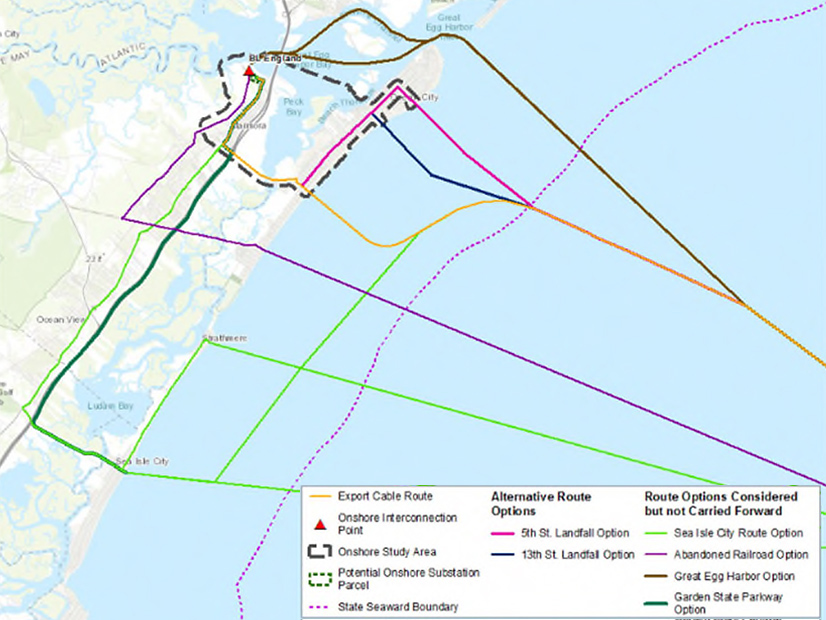
The New Jersey Board of Public Utilities (BPU) on Wednesday approved an easement sought by the state’s first offshore wind project, Ocean Wind 1, to run transmission onshore through Ocean City to a substation, removing a key obstacle to the project.
With little comment, the five-member board unanimously approved an order that said developer Ørsted had demonstrated that the easement for transmission to run underground across land developed with money from the state Green Acres program was “reasonably necessary” to the construction and operation of the wind project. Green Acres funds are awarded to develop parks and open space. The order also granted the project a series of consents needed to obtain environmental and other permits.
The BPU’s approval, in the face of opposition from Ocean City’s governing body and residents, opens the way for Ørsted to seek easement and permit approval from the New Jersey Department of Environmental Protection (DEP), which is needed for the project to get federal backing. Ocean City had asked the BPU to delay the project while an administrative hearing and environmental studies of the cable route are conducted.
However, the project still needs the BPU’s approval in a second case, in which the developer needs permission to run transmission on land owned by Cape May County and that government’s consent on permit approvals.
The Ocean City case was first test of a controversial law enacted in July 2021 that allowed offshore wind developers to site power cables and equipment on public land regardless of local or state government opposition. The outcome of the case could provide a roadmap for other projects facing similar opposition in the future.
The reasonably-necessary standard was set out in the law, which specifically prohibited municipal and county governments, and state agencies, from preventing the placement of offshore wind equipment if the BPU gave its approval. (See NJ Lawmakers Back Offshore Wind Bills.) Several speakers at public hearings into the easement argued that the law effectively disenfranchised local officials and removed their authority to make decisions on issues that would affect their residents.
Ørsted is seeking a 30-foot-wide easement running the length of the island on which the city is located, which is about 8 miles long. A 275-kV line will connect Ocean Wind’s turbines, about 15 miles offshore, to the PJM grid at a substation sited on a now closed coal-fired power plant in neighboring Upper Township.
Without the law in place, and the BPU’s power to override local authorities, the project would have needed Ocean City’s consent for several permit approvals, including Waterfront Development, Wetlands Act of 1970, Coastal Area Facilities Review Act, Flood Hazard Area Control Act and Freshwater Wetlands Protection Act, and a Tidelands License, among other permits, according to the order.
Those permits are required for the DEP to “issue a federal consistency determination, which is a prerequisite for Bureau of Ocean Energy Management’s (BOEM) approval of the project’s construction and operations plan,” according to the order.
The 1,100-MW Ocean Wind project, which was approved in 2019, was the first of three approved offshore wind farms by the state so far. The BPU has also approved the 1,148-MW Ocean Wind 2 and the 1,510-MW Atlantic Shores, and the state expects to hold a third solicitation, for 1,200 MW, in the first quarter of 2023. (See related story, NJ Seeks Stakeholder Input for 3rd OSW Solicitation.)
The BPU’s ruling came the day before it holds two online hearings on another easement for an underground transmission line from the Ocean Wind 1 project across land owned by Cape May County. In that case, Ørsted’s petition says Cape May officials have not responded to its efforts to secure approvals.
Public Opposition
Although the Ocean Wind project is strongly supported by government officials and embraced by environmentalists, Ocean City opposes the project, as do local residents, who say the nearly 100 turbines will tarnish their ocean view. Also opposed are commercial fishermen, who say it will hurt their ability to fish, and tourism interests, who fear fewer visitors will come to enjoy a shoreline with turbines on the horizon. (See Ørsted NJ Wind Project Faces Local Opposition.)
The board’s approval Wednesday in the Ocean City case followed two public hearings into the easement application and an online session in which Ørsted and the city presented oral arguments. Speakers in the two hearings opposed to the easement focused as much on their concerns about the project as a whole, and offshore wind in general, as on the details of the easement and how it would affect the community.
Mike DeVlieger, a former Ocean City councilman, said that “overwhelmingly our community is against this, and it’s not even close.” He added that “this presents medical concerns; it can present environmental concerns.”
But environmentalists argued that the threat of climate change is so serious that radical action was needed, and any potential disruption would not reach an unacceptable level.
Dorothy F. McCrosson, solicitor for the city, argued that Ocean Wind 1 could avoid the conflict with Ocean City if it opted to send the transmission through nearby Egg Harbor instead. In that scenario the beach and wetlands would not be disturbed and the streets would not be excavated.
She said the alternative route would present no disruption to Ocean City, but Ørsted had dismissed it earlier because it would be more expensive.
But attorney Gregory Eisenstark, representing Ocean Wind 1, said that once the construction was complete, there would be minimal disruption because the lines would be underground. He argued that the main reason that the city opposes the project “has to do with Ocean City’s overall objection to offshore wind.”
He argued that under the reasonably-necessary standard set out in the law, the route chosen by Ørsted just had to be a reasonable one. “It doesn’t have to be the best one. It doesn’t have to be the lowest-cost one.”

